When a poster (especially a vintage one) has "condition issues" that would interfere with
enjoying that poster when it is displayed, many collectors choose to have that poster professionally
"linenbacked", a process that ends with it mounted onto a linen backing (with Japanese rice paper
between the poster and the linen) and this makes the poster far easier to frame, and removes most or
all of its defects. (see far below for much, much more about how this is done).
We only auction linenbacked posters in our five annual major auctions and not in our regular
weekly auctions (although we also include a large number of unbacked items as well). If you
have never before purchased a linenbacked poster and might do so in the future, then you absolutely
should read the below information carefully. But you should also read it even if you already own
some or many linenbacked posters, because you may well learn a lot you did not know!
Now first, know that we've always included a link from our auctions of linenbacked posters to an
explanation of what exactly linenbacking is, and that reads as follows:
"Linenbacking" is a process that is used to preserve movie posters
(the best restorers de-acidify the poster during the restoration process), and to make them far
easier to display (it is much easier and less expensive to frame a linenbacked poster). When
linenbacking is done correctly, it adds to the value of the poster, and is NOT a defect! Note
that many of the linenbacked posters in this auction were well linenbacked, but the restorer did not
always attempt to make the poster look "perfect". On those posters, you may still see some evidence of the restoration
and/or the defects when you look at the poster from inches away. But most of those poster now look
nice from a reasonable viewing distance, and I think many collectors would be happy to display this poster on their wall
as it is.
In general, know that we received most of the linenbacked posters we are currently selling already
linenbacked, but we have examined every poster EXTREMELY carefully, and we did our best to
describe what condition the poster was in PRIOR to restoration, the defects the poster had PRIOR to restoration, any
unrestored defects, and, when it seemed worth noting, something about the quality of the restoration
itself. Many other auction houses claim to match what we do in this area, but EVERY person
who regularly buys movie posters from major auctions can tell you this is just not the case! We
never intentionally overgrade a single item, we never "accidentally" miss defects (or
misrepresent the amount of restoration an item has had), and we never
enhance a single image!
Here are some close-up photos of what the linen backing actually looks
like (each image is clickable to see a much larger image):
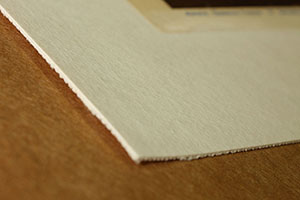
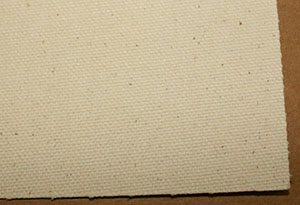
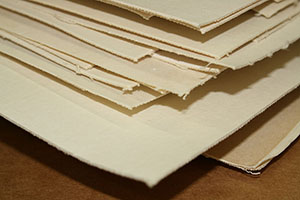
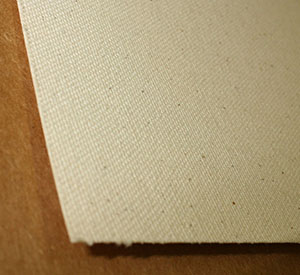
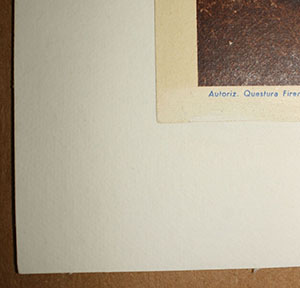
Over the years, we have been asked several different questions
concerning linenbacking, and we reproducing our answers taken from our past e-mail club messages
below (some are edited or revised, and they are grouped by the type of question being asked, which
is in bold):
Should I be worried about how restoration is being performed on
my poster?
Q: " I have a question that I'd like your opinion on. Last week I took a poster to be linen mounted
at one of the bigger poster gallery/restorers. While I was having my order written up I walked
around to watch the restorers putting the finishing touches on several old movie posters. I was
amazed to see them using Art Markers to do the touch ups to the folds and worn areas. To me this
seems permanent and irreversible. I thought colored pencils are what are commonly used as the
markers would permeate the paper. Is this a common practice? Would this be considered archival
restoration? What do you think?"
A: "This is one of the scariest issues in poster collecting. There are several restorers who use
irreversible methods of restoration, and this is very sad. It is most certainly not "archival
restoration". The only thing you as an individual can do is to try to make sure that anything you
get restored is done with reversible methods (such as colored pencil or watercolor paint). That
poster that looks great now may not look very good in ten years, and if irreversible methods were
used then the only way to "re-restore" the item will be to paint over everything yet again.
Eventually it will be hard to find the original poster under all the paint!"
How can an individual learn how to do his own linenbacking?
Q: "Thanks again for the weekly e-mails. I always learn SO much from each letter. I'd
like to thank the person who submitted the information about the de-acidification solution, and the
address from where it can be ordered. This has prompted my question Considering my affinity for many
artistic avenues, and considering the size of my collection versus the price of linen-backing, I
truly desire to learn the backing process. I already know the basics - 1st layer linen, 2nd layer
rice paper, 3rd layer poster. But what about the finer details such as stretching, what is used for
the "top coat", etc.? Where can the materials be obtained? Are printed procedures available
anywhere? Naturally, I would practice with scrap items before attempting to back anything of value.
Any help would be greatly appreciated! Many thanks."
A: The best way
to learn about doing your own linenbacking would be to go to work for one of the best linenbackers and learn how they do it!
Of course this is probably not practical for most people, and of course there are also a lot of mediocre linenbackers who do all kinds of
improper things (such as using acrylic paints), so if you do learn in this way, then be very sure you are learning the proper
conservation techniques, or you'll do more harm than good.
But now, with the Internet, you can get a vast amount of good free
information online! There are several online poster forums, and each has vary amounts of information
on do-it-yourself linenbacking, and you can join each forum and ask questions of the experts
yourself!
Does heavy restoration affect the value of a poster?
Q:
"This question may have been asked before, and I apologize if it has. I recently purchased a
half-sheet at a nationally known auction house (not yours), and found it's been heavily, but
professionally restored. Does this make the poster worthless?"
A : The heavy restoration does not make it worthless, but in my opinion it should definitely lessen the
value, especially depending on what you mean by heavy restoration. I have seen many posters where
the restorer repainted virtually the entire poster in order to make the new areas "blend" in with
the old, and I personally think that such restoration should greatly lessen the value. Unfortunately
there are several auctions that knowingly or unknowingly deceive bidders by describing such posters
as having "minor restoration" (which is awful, because buying at auction shouldn't be like walking
through a minefield!), so I'd advise everyone to be very sure of the
amount of restoration an item has had prior to your buying it (and ALL our past buyers know
that we ALWAYS tell the absolute truth about EVERY restored item WE auction).
The most important thing to recognize is that there's nothing wrong with
restoration (especially on rare items), as long as it's well done, you've been made aware of it, and the restoration is taken
into account in the price of the item.
Where can I find out more?
Q: "Is there a definitive guide to the preservation of vintage materials (or a history of how
it has changed over the years), and how might I obtain
it?"
A: I don't know of any such book or website that gives this information, so I will try to give a
brief outline here and now! First, I need to first give a brief history of
restoration. There were virtually no professional restorers in the 1960s or 1970s that I am aware
of. "Restoration" consisted mainly of scotch tape or masking tape, often applied in generous
amounts. A few people would patch the holes with pieces from other posters, and sometimes crude
drawing of missing parts was done. Often people would throw away posters that were "too far gone",
(too brittle, many stains, pieces missing, etc.). At the least they'd be sold at massive discounts.
Sometimes posters were linenbacked, but this usually was done directly on linen, and with little or
no attempt at restoration. In the early 1980s as prices began to rise, a few dealers learned of
restorers who could perform "magic" on damaged posters and lobby cards. They could bleach out
stains, replace missing parts, mend tears, and generally make a damaged item appear "like-new"
(especially to an unsophisticated eye). These dealers quickly made a lot of money buying lesser
condition items, restoring them, and then selling them as near-mint condition.
One of the first
full-time poster restorers was Igor Edelman. Igor, a Russian immigrant, is an extremely talented
artist and musician who had discovered that he had a great talent at restoring oil paintings. Stan Caiden, a leading Los Angeles poster collector at the time, discovered Igor, and started him on
movie posters. Over the next decade, Igor had a large studio with lots of employees, and many
regarded him as the premier poster restorer. Unfortunately Igor passed away a few years back, but
one of his best employees started his own restoration studio (see below). Over the years after Igor
started his work LOTS and LOTS of other restorers started as well (some great, some
not-so-great, and some downright awful). See the end of this article for a list of some of the ones
I recommend.
What is involved in linenbacking a one-sheet poster? (This is far and away the most commonly
restored size.) The poster is often first immersed in a liquid bath that de-acidifies the poster and
lightly bleaches it. The bleaching is hopefully light enough that stains are removed but the printed
inks are unaffected. Then the poster is mounted on Japanese rice paper, and then both are mounted on
linen. The linen is on a stretcher, and then the restorer begins by patching missing areas, and then
carefully painting in whatever has been lost, hopefully matching what was originally there as
closely as possible. The folds present a special problem, as often old posters will separate
partially or entirely when they are immersed. So painting may be necessary along every fold.
Finally, the poster is cut from the stretcher, and around an inch of border is left all around the
poster. (I have simplified a complicated process. I invite any restorers to enlarge or correct what
I have written.
This process typically costs $100 to $200 for a one-sheet from a talented restorer. Why is it done?
There are a few clear advantages. The poster is not fragile anymore, and can be easily rolled and
sent in a tube. It is much easier to frame, and framing will probably be less expensive. It will
look far superior visually, for it will lay perfectly flat, and the defects will be fixed, and there
are no distracting foldlines. The last two benefits are only for dealers. The posters can be taken
to shows or auctions and exhibited without damaging them, and (if a dealer or auction house is unscrupulous), they can deceive
the buyer as to the amount of restoration. What are the negatives? It is expensive. If you have a
lot of posters, restoration costs add up quickly. Many collectors with limited budgets would rather
buy more posters than spend money on restoration. Often the poster's value increases by less than
the cost of the restoration. The poster may be more difficult to sell, as collectors may be wary of
how much was wrong with the poster.
Now I want to talk
about when you should have restoration performed. It is a very personal decision, of course, but I
feel that unless you have a compelling reason to do something (especially if you want to frame it
and display it), then you should always do as little as
possible. My reasoning is simple. You can always have something done in the future, but you will
surely find that it is next-to-impossible (and very expensive) to undo what has been done. I also
urge all of you to not undertake amateur restoration. I know it sounds hard to believe, but my
personal experience is that more harm to posters has occurred through attempts at restoration than
from any other single cause. When people call me about their posters, the first question I ask is
what restoration, if any, has been performed. I am always much happier if the material is
unrestored.
But let's assume that you have a poster that you feel must be restored (it has a big
hole, it's stained, etc). What's your next step? First, let me tell you about
is the different types of restorers.
Basically, there are four types of restorers:
1) The do-it-yourselfers. These people use various chemicals (such as lighter fluid) to remove old
tape, and then use various home remedies (such as filling in gaps with small pieces from other
posters, and using colored pencils or markers) to improve the the poster's appearance. The problem I
have with this type of repair is that while it will improve the poster's appearance in the short
run, it often causes real problems after years go by. But I know that nothing I say will stop most
of these "restorers". I just would urge them to start using only conservation materials, which are
available in any good art supply store.
2) One-man (or woman) restoration studios. These usually consist of one person who has learned the
art of linenbacking, but often is weak in the art of repair. They usually do a great job with simple
linenbacking of good condition posters, or ones with minor flaws, but often deliver an inferior job
when the poster needs significant repair. Their prices are often much less than the next two
categories, and in a few cases these "one man" places deliver BETTER work than many of the large
places, and their prices are almost always somewhat lower.
3) Large restoration studios. They have a lot of employees and
restore lots of posters every week. They often do a fine job, but the multiple employees result in
quality control problems. Some employees do much better work than others, and you won't know which
you're getting until after the job is done.
4) Museum restorers. These are places that primarily restore various kinds of fine art, but also do
some movie posters. They use the finest conservation techniques, and their work is far superior to
those in the first three categories. Unfortunately, their price is often five times the cost of the
restoration studios, so they are rarely used except for very special items.
There is major overlap between the types of restorers, but this is just to get you started. The
biggest problems people run into with restorers are the following:
1) It takes forever. Some restorers are like carpenters or plumbers. They love to start new jobs,
but have trouble finishing them. They often take on far more work than they can handle, and then run
far behind schedule. This is especially frustrating because they have your items the entire time.
2) Late in the day they tell you the price is much more than originally quoted. They will often say
the poster is harder than it originally seemed. By then the poster is half done, and there's not
much the customer can do.
3) Some restorers use acrylic paint to repair the poster. Often the paint bonds with the paper and
can't be reversed. Sometimes the restoration ages differently from the rest of the poster, and after
a few years looks terrible.
4) Some restorers repaint huge sections of the poster. To an uneducated eye, the poster looks great,
but some experts shun such posters as being over-restored.
Of course these problems do not occur every time, or no one would have their posters restored. I
just want to make you aware of some of the problems people run into, so you can better decide how to
proceed with your posters. Restoration is a wonderful tool, when performed well. It has rescued
many, many posters that would have little value if they could not be restored. Personally, my
biggest complaint is that all too often the amount of restoration is concealed from the ultimate
buyer, especially in many auctions which hide behind a "buyer beware" policy.
There is nothing wrong
with buying restored items as long as you are fully aware of how much restoration they have had!
Finally, I want to discuss how to determine how much restoration a poster has had. When a poster is
linenbacked, it often takes an expert to tell how much restoration has been performed, and even they
are often fooled.
The absolute best way to examine a linenbacked poster is to hold it in front of a very bright light
(a couple of 100 watt bulbs will probably work, but 500 or 600 watts is much better). Shining a
black light at the poster will also reveal where much paint has been applied. Holding it in front of
a very bright light will
illuminate the areas of restoration and you will be able to easily see most of what's been done to
the poster. Of course few dealers or auction houses will allow you to examine the posters in this
way, so you should try to purchase from those dealers that have an unrestricted return policy (as I
do), so that you'll be able to examine the poster in your home, and return it if it has excessive
restoration. Incidentally, I suggest that those of you who have linenbacked posters examine them
yourselves as I've described above. You might be surprised at what you see.
Here are links to SOME of the restorers we recommend (but we suggest you search the
Internet for information about ANY restorer you are considering using, so you can find the
very best for the type of poster you have, and so you can avoid the "bad apples" that are out
there):
Lumiere Poster Restoration (http://lumiereposter-restoration.com/)
is run by the former employee of Igor Edelman, and has over 21 years of experience!
Dario Casadei's Vintage Movie Art (http://www.vintagemovieart.ca/)
is an excellent restorer located in Vancouver, Canada (the only restorer we are aware of in Canada).
Studio C (http://www.atstudioc.com/) has been
a major restoration studio top collectors and auctions for many, many years!
See also:
Did you know... that folds in most "older" one-sheet movie posters are normal?
Did you know... that many people have different views on how to best store their movie paper
collection?
Did you know... that professional restoration usually increases a poster's value and amateur
restoration usually lessens a poster's value?
Did you know... that there definitely are good and bad ways to store your movie paper?











